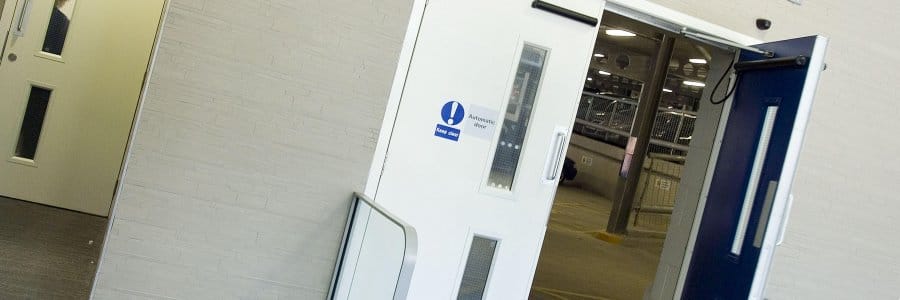What you need to know about external fire doors (more commonly known as Fire Exits)
We’ve talked quite a lot about internal fire doors over past months, and much less about external fire doors or fire exits, so this week we’ll spend some time on them. We’ll begin with the differences between the two types of door.
Differences between external and internal fire doors
An internal fire door is designed to compartmentalise a section of a building in the event of a fire and protect an escape route through it for a minimum length of time (as we saw last week, starting at 30 minutes and going right through to 240 minutes).
An external fire door at the end (i.e. the boundary to the outside and safety) of an escape route
- does not need to have fire resisting properties, and
- does not need to be kept closed
Its purpose is to enable the swift exit of people to safety.
We’re sometimes asked, incidentally, whether a designated fire exit can also legally be used as a regular entrance/exit door i.e. for every day use. The answer is yes it can – indeed the fact that it is in daily use makes it ideal as an escape route as its location is well known. Notwithstanding the security issue, which we’ll cover below, you just need to make sure that it complies with the regulations for fire doors (e.g. how it is opened from the inside and that is well signposted) and that it is never blocked.
The security issue
The fact that external fire doors, by their very nature, open onto the outside world, and (reference the regulations) “must not be so locked or fastened that they cannot be easily and immediately opened by any person who may require to use them”) causes an obvious tension between the two functions.
This tension is recognised in the various Government guides to fire safety risk assessment in public and commercial premises published by the Department for Communities and Local Government (DCLG). For example, the guide to “Large Places of Assembly” (May 2006) states that “guidance on fire exits starts from the position that doors on escape routes should not be fitted with any locking devices”, but goes on to note that the security aspect can be addressed by the installation of dedicated hardware that prevents unlimited access but still enables the occupants of a building or area to open the door easily if there is a fire.
This leads us onto the different types of external fire doors.
External fire door alternatives
- “panic” or “push” bars. We’re all familiar with these. As the name implies, they are easy to operate in a panic situation simply by pushing down. Clearly they are only suitable for doors that can only open outwards, and must be clearly labelled (e.g. PUSH TO OPEN). These are particularly effective when large numbers of people are evacuating quickly, as minimal pressure is required to release the locking mechanism
- emergency or “push” pads. Similar to panic bars, but are small pads instead of horizontal bars. They should of course also be accompanied by a sign explaining the mode of operation. These are suitable for doors where panic is unlikely (e.g. for the exclusive use of staff intimately familiar with the building layout) and NOT for the general public
- the use of so-called “barrel bolts”, but with the stop (which prevents the bolt from being withdrawn too far) removed at installation. Although frequently used in the past, these are not recommended – particularly if the door is the ONLY means of escape – as they can occasionally stick and thus make the bolt difficult to withdraw
- Redlam bolts. These bolts fit into a tube, which when broken automatically slides back the bolt and unlocks the door. As with push pads, they are only suitable for use by staff and NOT for the general public
- Kingpin emergency bolts. Similar to Redlam bolts, these have a handle which when pulled releases the spring-loaded bolt and unlocks the door.
These solutions are suitable for the vast majority of exit fire doors. There are some premises, however, such as high security buildings, where other more sophisticated mechanisms need to be employed (e.g. mechanisms relying on electromagnetism such as Maglocks or Shearmags).
How to get expert advice
As you can see, and as we often say, it’s a very complex topic – so you need to talk to experts who specialise in the manufacture and installation of external fire doors – and who can give you excellent advice and guidance based on years of successful installations and a large and satisfied customer base.
If you would like further information on you can use our contact form or call us on 020 3199 5862.
As always we’ll be delighted to help and advise you.









